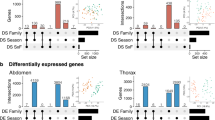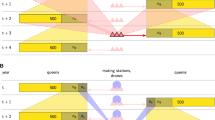Abstract
A novel use of selection was applied to the examination of the genetics of phenotypic plasticity. The approach provides a sensitive way of detecting genotype-environment (g × e) interactions and also allows the form of any interactions across an environmental gradient to be investigated through changes in the shapes of the reaction norms. The wing pattern of the butterfly B. anynana varies with season; eyespot size increases with development temperature. Selection lines to increase and to decrease eyespot size at 28°C were carried out. The effect of selection on the eyespot reaction norms with temperature was examined. Selection produced divergent reaction norms across the entire range of temperature in most eyespots. Significant g × e interactions were sometimes present but the degree of interaction was always relatively small. When present, the form of the interaction varied between the sexes. There was a high degree of genetic independence between the eyespots on the ventral and on the dorsal wing surfaces, except in the dorsal eyespot in the wing cell corresponding to the wing cell of the selected ventral wing surface eyespot. The significance of the results for the maintenance of genetic variation in B. anynana is considered.
Similar content being viewed by others
Article PDF
References
Bradshaw, A D. 1965. Evolutionary significance of phenotypic plasticity in plants. Adv Genet, 13, 115–155.
Brakefield, P M, and Larson, T B. 1984. The evolutionary significance of dry and wet season forms in some tropical butterflies. Biol J Linn Soc, 22, 1–12.
Brakefield, P M, and Reitsma, N. 1991. Phenotypic plasticity, seasonal climate and the population biology of Bicyclus butterflies (Satyridae) in Malawi. Ecol Entomol, 16, 291–303.
Brambilla, D J. 1980. Seasonal changes in size at maturity in small pond Daphnia. In: Kerkfoot, W. C. (ed.) Evolution and Ecology of Zooplankton Communities, pp. 438–455. Hanover, NH.
Caswell, H. 1983. Phenotypic plasticity in life-history traits: demographic effects and evolutionary consequences. Am Zool, 23, 35–46.
Condamin, M. 1973. Monographie du genre Bicyclus (Lepidoptera Satyridae). Mémoires de l'Institut Fondamental d'Afrique Noire, no. 88, Ifan-Dakar.
David, J R, Capy, P, and Gauthier, J-P. 1990. Abdominal pigmentation and growth temperature in Drosophila melanogaster: similarities and differences in the norms of reaction of successive segments. J Evol Biol, 3, 429–445.
Dodson, S I. 1974. Adaptive change in plankton morphology in response to size-selection prédation: a new hypothesis of cyclomorphosis. Limnol Oceanogr, 19, 721–729.
Dodson, S I. 1989. Predator-induced reaction norms. Bioscience, 39, 447–452.
Ebert, D, Yampolsky, L, and Van Noordwijk, A J. 1993. Genetics of life history in Daphnia magna. II. Phenotypic plasticity. Heredity, 70, 344–352.
Falconer, D S. 1989. Introduction to Quantitative Genetics, 3rd edn, p. 438. Longman, Harlow, UK.
French, V, and Brakefield, P M. 1992. The development of eyespot patterns on butterfly wings: morphogen sources or sinks? Development, 116, 103–109.
Gabriel, W, and Lynch, M. 1992. The selective advantage of reaction norms for environmental tolerance. J Evol Biol, 5, 41–59.
Gavrilets, S, and Scheiner, S M. 1993a. The genetics of phenotypic plasticity. V. Evolution of reaction norm shape. J Evol Biol, 6, 31–48.
Gavrilets, S, and Scheiner, S M. 1993b. The genetics of phenotypic plasticity. VI. Theoretical predictions for directional selection. J Evol Biol, 6, 49–68.
Gebhardt, M D, and Stearns, S C. 1993a. Phenotypic plasticity for life history traits in Drosophila melanogaster. I. Effect on phenotypic and environmental correlations. J Evol Biol, 6, 1–16.
Gebhardt, M D, and Stearns, S C. 1993b. Phenotypic plasticity for life history traits in Drosophila melanogaster. II. Epigenetic mechanisms and the scaling of variances. J Evol Biol, 6, 17–29.
Gillespie, J H, and Turelli, M. 1989. Genotype-environment interactions and the maintenance of polygenic variation. Genetics, 121, 129–138.
Gomulkiewicz, R, and Kirkpatrick, M. 1992. Quantitative genetics and the evolution of reaction norms. Evolution, 46, 390–411.
Groeters, F R, and Dingle, H. 1987. Genetic and maternal influences on life history plasticity in response to photo-period by milkweed bugs (Oncopeltus fasciatus). Am Nat, 129, 332–346.
Gupta, A P, and Lewontin, R C. 1982. A study of reaction norms in natural populations of Drosophila pseudoobscura. Evolution, 36, 934–948.
Hartl, D L. 1980. Principles of Population Genetics. Sinauer Associates, Sunderland, MA.
Hill, J T, and Gatehouse, A G. 1993. Phenotypic plasticity and geographical variation in the pre-reproductive period of Autographa gamma (Lepidoptera: Noctuidae) and its implications for migration in this species. Ecol Entomol, 18, 39–46.
Hillesheim, E, and Stearns, S C. 1991. The responses of Drosophila melanogaster to artificial selection on body weight and its phenotypic plasticity in two larval food environments. Evolution, 45, 1909–1923.
Holloway, G J. 1993. Phenotypic variation in colour pattern and seasonal plasticity in Eristalis hoverflies (Diptera: Syrphidae). Ecol Entomol, 18, 209–217.
Holloway, G J, Brakefield, P M, and Kofman, S. 1993a. The genetics of wing pattern elements in the polyphenic butterfly, Bicyclus anynana. Heredity, 70, 179–186.
Holloway, G J, De Jong, P W, and Ottenheim, M. 1993b. The genetics and cost of chemical defense in the two-spot ladybird (Adalia bipunctata L.). Evolution, 47, 1229–1239.
Hughes, D J. 1992. Genotype-environment interactions and relative clonal fitness in a marine bryozoan. J Anim Ecol, 61, 291–306.
De Jong, G. 1990a. Quantitative genetics of reaction norms. J Evol Biol, 3, 447–468.
De Jong, G. 1990b. Genotype by environment interaction and the genetic covariance between environments: multilocus genetics. Genetica, 81, 171–177.
Kingsolver, J G, and Wiernasz, D C. 1991. Seasonal polyphenism in wing-melanin pattern and thermoregulatory adaptation in Pieris butterflies. Am Nat, 137, 816–830.
Koch, P B. 1992. Seasonal polyphenism in butterflies: a hormonally controlled phenomenon of pattern formation. Zool Jb Physiol, 96, 227–240.
Maynard Smith, J, Burian, R, Kauffman, S, Alberch, P, Cambell, J, Goodwin, B, Lande, R, Raup, D, and Wolpert, L. 1985. Developmental constraints and evolution. Q Rev Biol, 60, 265–287.
Newman, R A. 1988. Adaptive plasticity in development of Scaphiopus couchii tadpoles in desert ponds. Evolution, 42, 774–783.
Nijhout, H F. 1980. Pattern formation on lepidopteran wings: determination of an eyespot. Devel Biol, 80, 267–214.
Nijhout, H F. 1990. A comprehensive model for colour pattern formation in butterflies. Proc R Soc B, 239, 81–113.
Nijhout, H F. 1991. The Development and Evolution of Butterfly Wing Patterns. Smithsonian Institute Press, Washington and London.
Nylin, S. 1989. Effects of changing photoperiods in the life cycle regulation of the comma butterfly, Polygonia c-album (Nymphalidae). Ecol Entomol, 14, 209–218.
Parejko, K, and Dodson, S I. 1991. The evolutionary ecology of an antipredator reaction norm: Daphnia pulex and Chaoborusamericanus. Evolution, 45, 1665–1674.
Platenkamp, G A J, and Shaw, R G. 1992. Environmental and genetic constraints on adaptive population differentiation in Anthoxanthum odoratum. Evolution, 46, 341–352.
Rawson, P D, and Hilbish, T J. 1991. Genotype-environment interaction for juvenile growth in the hard clam Mercenaria mercenaria (L.). Evolution, 45, 1924–1935.
Scheiner, S M. 1993. Plasticity as a selectable trait: reply to Via. Am Nat, 142, 371–373.
Scheiner, S M, Caplin, R L, and Lyman, R F. 1991. The genetics of phenotypic plasticity. III. Genetic correlations and fluctuating asymmetries. J Evol Biol, 4, 51–68.
Scheiner, S M, and Lyman, R F. 1989. The genetics of phenotypic plasticity. I. Heritability. J Evol Biol, 2, 95–107.
Scheiner, S M, and Lyman, R F. 1991. The genetics of phenotypic plasticity. II. Response to selection. J Evol Biol, 4, 23–50.
Schlichting, C D. 1986. The evolution of phenotypic plasticity in plants. Ann Rev Ecol Syst, 17, 667–693.
Schlichting, C D. 1989. Phenotypic plasticity in Phlox. II. Plasticity of character correlations. Oecologia, 78, 496–501.
Schlichting, C D, and Pigliucci, M. 1993. Control of phenotypic plasticity via regulatory genes. Am Nat, 142, 366–370.
Schmalhausen, I I. 1949. Factors of Evolution. Blakiston, Philadelphia.
Shapiro, A M. 1976. Seasonal polymorphism. Evol Biol, 9, 259–333.
Spitze, K. 1992. Predator-mediated plasticity of prey life history and morphology: Chaoborus americanus predation on Daphnia pulex. Am Nat, 139, 229–247.
Stearns, S C. 1989. The evolutionary significance of phenotypic plasticity. Bioscience, 39, 436–445.
Stearns, S C, and Koella, J C. 1986. The evolution of phenotypic plasticity in life-history traits: predictions of reaction norms for age and size at maturity. Evolution, 40, 893–913.
Strathmann, R R, Fenaux, L, and Strathmann, M F. 1992. Heterchronic developmental plasticity in larval sea urchins and its implications for evolution of nonfeeding larvae. Evolution, 46, 972–986.
Sultan, S E. 1987. Evolutionary implications of phenotypic plasticity in plants. Evol Biol, 20, 127–178.
Van Noordwijk, A J. 1989. Reaction norms in genetical ecology. Bioscience, 39, 453–458.
Van Noordwijk, A J, and Gebhardt, M. 1987. Reflections on the genetics of quantitative traits with continuous environmental variation. In: Loeschcke, V. L. (ed.) Genetic Constraints to Adaptive Evolution, pp. 73–90. Springer, Berlin.
Van Oosterhout, C, Brakefield, P M, and Kooi, R E. 1993. Phenotypic plasticity and life history traits in selection lines of Bicyclus anynana. Proc Exp Appl Entomol, 4, 163–168.
Via, S. 1984. The quantitative genetics of polyphagy in an insect herbivore. I. Genotype-environment interaction in larval performance on different host plant species. Evolution, 38, 881–895.
Via, S. 1993. Adaptive phenotypic plasticity: target or byproduct of selection in a variable environment? Am Nat, 142, 352–365.
Via, S, and Lande, R. 1985. Genotype-environment interaction and the evolution of phenotypic plasticity. Evolution, 39, 505–522.
Via, S, and Lande, R. 1987. Evolution of genetic variability in a spatially heterogeneous environment: effects of genotype-environment interaction. Genet Res, 49, 147–156.
Wade, M J. 1990. Genotype-environment interaction for climate and competition in a natural population of flour beetles, Tribolium castaneum. Evolution, 44, 2004–2011.
Weber, K E. 1992. How small are the smallest selectable domains of form? Genetics, 130, 345–353.
Weber, S L, and Scheiner, S M. 1992. The genetics of phenotypic plasticity. IV. Chromosomal localization. J Evol Biol, 5, 109–120.
Weeks, S C. 1993. Phenotypic plasticity of life history traits in clonal and sexual fish (Poeciliopsis) at high and low densities. Oecologia, 93, 307–314.
Weis, A E, and Gorman, W L. 1990. Measuring selection on reaction norms: an exploration of the Eurosta-Solidago system. Evolution, 44, 820–831.
West-Eberhard, M J. 1989. Phenotypic plasticity and the origins of diversity. Ann Rev Ecol Syst, 80, 249–278.
Windig, J J. 1992. Seasonal polyphenism in Bicyclus safitza: a continuous reaction norm. Neth J Zool, 42, 583–594.
Windig, J J. 1993. The Genetic Background of Plasticity in Wing Pattern of Bicyclus Butterflies. Ph.D. Thesis, University of Leiden.
Williams, G C. 1966. Adaptation and Natural Selection. Princeton University Press, Princeton, NT.
Wolterek, R. 1909. Weitere experimentelle Untersuchungen über Artveränderung, speziell über das Wesen quantitativer Artenunterschiede bei Daphniden. Verh D Tsch Zool Ges, 1909, 110–172.
Author information
Authors and Affiliations
Rights and permissions
About this article
Cite this article
Holloway, G., Brakefield, P. Artificial selection of reaction norms of wing pattern elements in Bicyclus anynana. Heredity 74, 91–99 (1995). https://doi.org/10.1038/hdy.1995.11
Received:
Issue date:
DOI: https://doi.org/10.1038/hdy.1995.11



